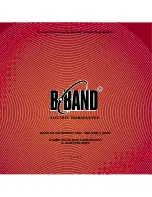
24
SD Series Technical Manual
MDS 05-4846A01, Rev. F
COM2 (Data) Connections
Typically, the
COM2
port (Figure 19) is used for connecting the radio to
an external DTE serial device supporting the RS-232 or RS-485 serial
data format. The radio supports serial data rates of 300, 1200, 2400,
4800, 9600, 19200, and 38400, 57600, 115200 bps (asynchronous only).
Pin
Descriptions—RS-2
32 and RS-422/485
Mode
Table 8 and Table 9 provide detailed pin descriptions for the
COM2
data
port
in RS-232 mode and RS-422/485 modes, respectively.
NOTE:
The radio is hard-wired as a DCE device.
6
--
No function
7
--
No function in most applications—User I/O for special
applications
8
---
No function
9
--
No function in most applications—User I/O for special
applications
Table 7. COM1 Pin Descriptions
Pin
Number
Radio
Input/
Output
Pin Description
Figure 19
.
COM2 Connector (DB-9F)
As viewed from outside the radio
Table 8. COM2 Pin Descriptions
—Radio in RS-232 Mode
Pin
Number
Radio
Input/
Output
Pin Description
1
OUT
DCD (Data Carrier Detect/Link)
—A low indicates signal
received.
2
OUT
RXD (Received Data)
—Supplies received data to the
connected device.
3
IN
TXD (Transmitted Data)
—Accepts TX data from the
connected device.
4
IN
Sleep Mode Input
—Grounding this pin places the radio in a
low power consumption mode.
5
--
Signal Ground—
Connects to ground (negative supply
potential) on chassis.
6
OUT
Alarm Output (DSR)—
Behavior is user-configurable.
Default
behavior:
An RS-232 high/space (+5.0 Vdc) on this pin
indicates an alarm condition. An RS-232 low/mark (–5.0 Vdc)
indicates normal operation.
7
IN
RTS (Request-to-Send)
—Keys the transmitter.
5
9
6
1
















































